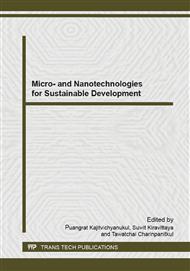p.1
p.9
p.15
p.21
p.29
p.37
p.45
p.53
Effect of pH and Freezing Condition on Cryogel Encapsulation of Curcumin
Abstract:
The aim of this study was to develop a pH-sensitive ternary system of chitosan, κ-carrageenan, and carboxymethylcellulose sodium salt (CMC) that can serve as a controlled release system. Encapsulation of curcumin in chitosan was achieved by transforming the present colloidal suspension into hydrogels via cryotropic gel formation. The frozen hydrogel specimens (cryogels) were freeze-dried for preservation and investigation. It was reported that, when the ratio of κ-carrageenan to NaCMC was kept constant, the cooling rate was found to determine the type of release between burst type and controlled first-order-rate type [1]. The microstructural morphology of freeze-dried specimens was observed with a Scanning Electron Microscope (SEM) to be affected by the cooling rate. The faster cooling rate produced specimens with slightly larger pore size and, as a result, higher amount of curcumin released at 2 days. Swelling tests of the hydrogels in buffer solutions of different pH values showed that acidic media had a pronounced effect on swelling compared to the neutral and alkaline media. The faster cooling rate produced specimens that had higher structural strength against swelling despite the fact that the specimens had larger pore size and faster controlled release rate.
Info:
Periodical:
Pages:
9-14
Citation:
Online since:
May 2015
Keywords:
Price:
Сopyright:
© 2015 Trans Tech Publications Ltd. All Rights Reserved
Share:
Citation:


